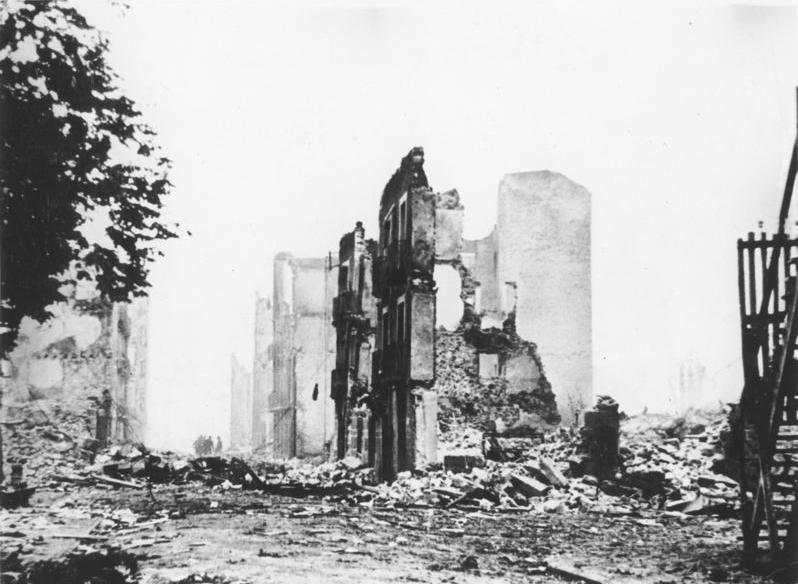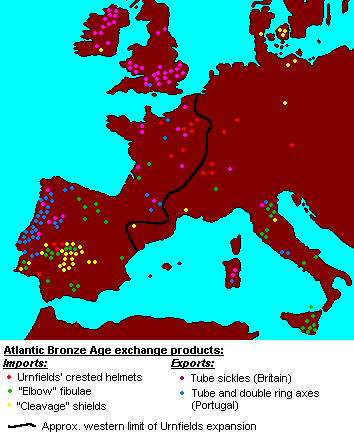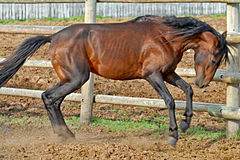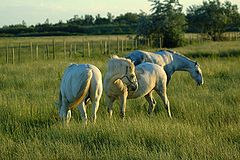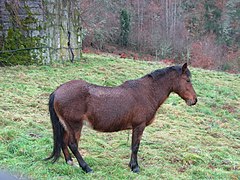What follows was sent to me by Argiedude with offer of publishing. I believe it has some interest, so here it is, however publication does not necessarily imply agreement by the blog's author (see comments section).
_____________________________
I've made a map of the main y-dna haplogroups of Iberia, using all the y-dna studies I could find, totaling some 3000 Spanish and 2000 Portuguese samples, though it varies depending on the haplogroup. The graph below shows the results:
 |
| click to enlarge |
There are 10 haplogroups, excluding SRY-2627 and M153, which are redundant with R1b1b2. 7 of the 10 have clear east-west gradients. The other 3 have no gradient, though for G a weak east-west gradient could be argued. None have a north-south gradient.
Not only is there an east-west gradient, but it follows a specific pattern, dividing Iberia into 2 halves. And there is a curious anomaly in the otherwise perfect 2 halves, which can be easily seen in the image below:

Valencia, in the far east, consistently has a y-dna composition that is more akin to western Iberia. The image even underestimates this similarity, because E-M81 is higher in Valencia than in the rest of east Iberia, but it just barely didn't make the threshold to be included with the western half, so the image shows Valencia as scoring 4 of 6 similarity with western Iberia when it should perhaps be 5 of 6 (after including E-M81). I didn't include a few haplogroups because they were too small (1% or less frequency), but 2 of them, E-M123 and E1a1+E1b1a, also had a frequency peak in Valencia higher than in the rest of east Iberia and similar to western Iberia. So I don't think that the results for Valencia are random. As a final note, Valencia consisted of 300 samples, which is a respectable sample size.
The frequencies in the western half seems to be more uniform, while the frequencies in the eastern half are more jumpy. In particular, the west coastal strip, from south Portugal to Galicia, is remarkably similar, in all haplogroups. I think the y-dna of Iberia used to be like western Iberia today. There was a disruption that altered the eastern half. This would explain the anomaly of Valencia: it wasn't as badly affected by the disruption as the rest of east Iberia, thus retaining a more western y-dna composition.
IMPLICATIONS FOR TMRCA
E-M81 has one of the youngest age estimates (TMRCA) of any major haplogroup, about 2000 years old. The first image shows it to follow the typical east-west pattern in Iberia almost perfectly, second only to R1b1b2 (which is perfect). So was E-M81 part of the original older stratum of y-dna in Iberia? This would fly in the face of the TMRCA age estimates for E-M81. E-M81 is so young, and at the same time identical in haplotype to North African E-M81, that we are forced to adscribe its presence in Iberia to the Arab invasion starting in 700 AD. But the maps paint a completely different picture, not only showing a geographic distribution that makes no sense at all with a historic Arab origin, but also because E-M81's notorious similarity to the repeat pattern of east-west distribution seen in most other haplogroups indicates that its distribution must have been molded by whatever events also produced the distribution patterns in all those other haplogroups. It seems extremely unlikely that E-M81 would have been born 2000 years ago in North Africa, became diffused in Iberia between 700 AD and 1200 AD, and only then something occured which rearranged Iberia's y-dna, all of it, into the now observed patterns of east and west halves. This unlikely scenario would have to be nothing less than a complete and total population rearrangement, no half measures, given that E-M81 is actually higher (much higher) in regions barely occupied by the Moors than in the stronghold of Granada, where the Moors ruled for 800 years.
It should also be noted that North Africa has 2 major haplogroups, E-M81 and J1-L222, found at about 50% and 25% respectively, from Morocco to Libya. But in Iberia, while E-M81 is present at 4% in Spain and 5% in Portugal, J1-L222 is not found at all in Portugal and is only found at 0.05% in Spain. This is also repeated in thousands of Latin American samples, where E-M81 is about 4% and J1-L222 is 0.1%. A historic recent diffusion from North Africa would obviously have spread 2 E-M81 samples for every 1 J1-L222 sample, as per their frequencies in North Africa, but instead we see that the ratio between E-M81 and J1-L222 in Iberia is 75 to 1. Likewise in south Italy the ratio is 20 to 1.
To summarize, on top of previous evidence over the last 2 years undermining the extremely young age estimate of E-M81, which consisted of the obvious east-west distribution of E-M81 in Iberia and the anomaly of J1-L222 not being found even close to proportion with the presence of E-M81 in Iberia, we can now add the fact that E-M81's distribution in Iberia isn't an oddity, but in fact the typical pattern of distribution of most Iberian haplogroups, which obviously points to deeper causes for its diffusion in the peninsula, unless Iberia's population has been completely and totally rearranged in very recent history. This is not just about Iberia, but about the theory of TMRCA itself, which as you may have guessed by now, I completely disagree with: I think all y-dna haplogroups are older than their currently estimated ages (per TMRCA) by orders of multiples.
A final note to round out this observation is the fact that most haplogroups are higher in the west than in the east, which sometimes really doesn't make sense, most notably in the case of E-V13, which would have come from eastern Europe via land and should have had a higher frequency in east Iberia.
ODDS AND ENDS OF IBERIA'S Y-DNA
Ibiza has 2 clusters specific to its island in the haplogroups G and T. The cluster in G has a modal haplotype identical to the general G haplotype, but the T cluster has a very distinctive modal haplotype, which I haven't found in any sample from anywhere else in Iberia or Latin America; so far, it's only observed in Ibiza, not even Majorca and Minorca.
There's something strange going on in the Cantabria/Basque region. Cantabria has an unusually very high rate for R1a and E-M81, and the Basques for R-M153. Very few regions have any single haplogroup with a highly divergent frequency, but these 2 neighbors manage to have 3 such events. The y-dna differences between Basque and Cantabria are the sharpest y-dna clines by far in Iberia. And of course, Cantabria belongs to the western half and the Basques to the eastern half of the Iberian y-dna divide. Cantabria's R1a and E-M81 seem to extend westwards, resulting in lower but still unusually high frequencies of both haplogroups in Galicia, Asturias, and Castile, but in both cases the haplogroups can't manage to diffuse eastwards even as far as the Basque region. Likewise, R-M153, very high in the Basque region, has a notable tendency to spread to the rest of east Iberia, but it can hardly manage to cross west into Cantabria and beyond.
The haplogroups I included in these images amounted to 93% of Iberia's y-dna. Most of the remaining 7% belonged to E1b1b (M35) lineages, except E-M81 and E-V13.
 |
| click to expand |
_____________________________
See also at Leherensuge (by Maju):
 In another discussion, Terry brought up this recent paper on O2b and Korean patrilineages (with important references to the rest of East Asia) that I believe is worth mentioning:
In another discussion, Terry brought up this recent paper on O2b and Korean patrilineages (with important references to the rest of East Asia) that I believe is worth mentioning:
